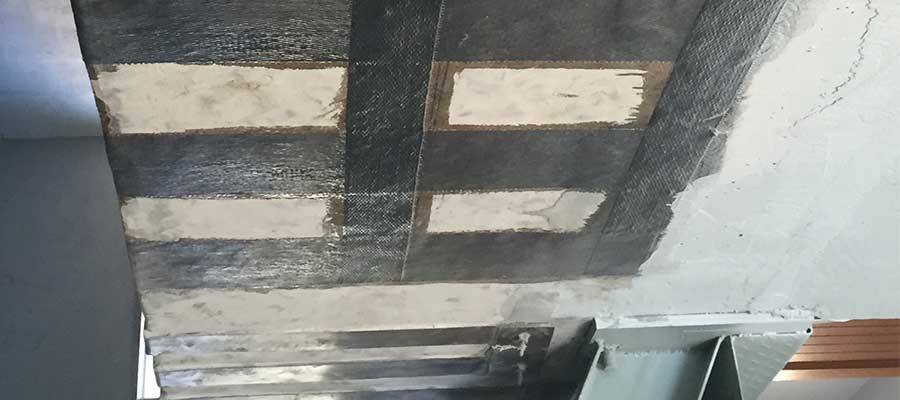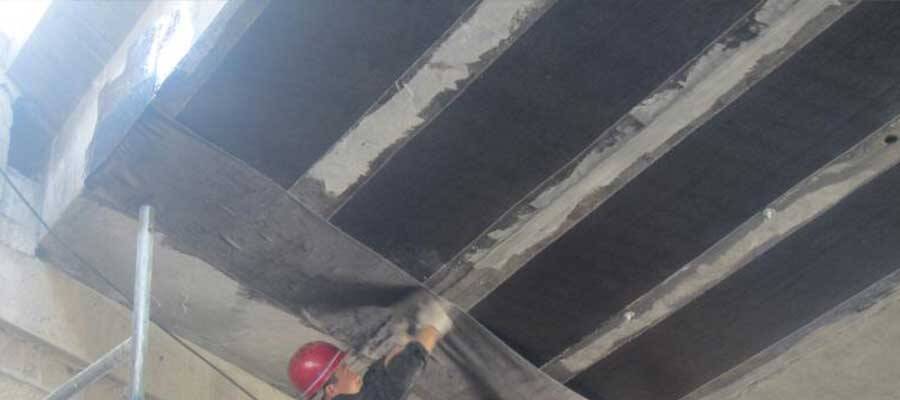Beams Strengthening with Carbon Fiber
Carbon fiber reinforcement technology will be more widely used with the implementation of safety projects in primary and secondary schools throughout the country.
After comprehensive analysis and consideration, it is determined that the main reinforcement technologies of the school building structure are wrap concrete reinforcement technology and carbon fiber reinforcement technology.
The reinforcement project of the teaching building, a four-storey brick-concrete structure, was built in the early nineties of last century. According to the relevant requirements of the state, the school buildings must meet the design standards of Class B buildings, and carry out structural seismic checking calculation according to the requirements of 8-degree seismic fortification.
The design department carries out structural appraisal and seismic bearing capacity checking according to the construction age of the school building and the design specifications, structural characteristics, structural layout, structure and seismic bearing capacity. After comprehensive analysis and consideration, it is determined that the main reinforcement technologies of the school building structure are wrap concrete reinforcement technology and carbon fiber reinforcement technology.

Carbon fibre reinforcement technology is to use high-strength carbon fibre products arranged in the same direction to adhere to the surface of concrete structure tightly by special chemical bond. Without increasing the load and size of the structure, the purpose of strengthening and reinforcing the strengths of the strengthened members is achieved.
(1) Carbon fibre reinforcement can enhance the bending resistance of members.
(2) The flexural tension surface of beam and column, staircase board, prefabricated board and other components of the school building;
(3) CFRP reinforcement can improve the shear resistance of members. It is suitable for the exterior surfaces of school buildings such as columns, beams and boards.
(4) CFRP reinforcement can prolong the service life of components, increase load and repair cracks.
(5) Suitable for cracks on floor, bridge floor and concrete structure surface.
Advantages of CFRP reinforcement:
(1) High strength (about l0 times the strength of ordinary steel), good effect;
(2) The corrosion resistance and durability of the structure can be greatly improved after the Jl is fixed.
(3) Light self-weight (about 200 g/m), no increase in structure self-weight and cross-section size, good flexibility, easy cutting, wide application range;
(4) The construction is simple (no large construction institutions and turnover materials are needed), easy to operate and economical.
(5) The construction period is short (only one week for this project example). Therefore, the strengthening technology of carbon fiber reinforced concrete structure has produced great effect.
After calculation, the flexural capacity of the normal section of the beam is insufficient, and the tensile capacity of the stairs is insufficient. Therefore, CFRP is pasted in the tension zone of the beam for flexural reinforcement, and CFRP is pasted at the bottom of the staircase plate for tensile reinforcement.
The concrete construction process is as follows: equipment work, component base treatment, brushing base glue, repairing and leveling, pasting carbon fiber cloth and protection treatment.

Check before acceptance
Three days after construction, the total effective bonding area should not be less than 95% by lightly striking the surface of carbon fiber sheet with metal hammer or by hand pressing. When the area of empty drum of carbon fiber cloth is less than 1000mm, it can be repaired by needle and tube injection, and extruded by hand or drum to eliminate empty drum. When the area of empty drum is larger than 1000 mm2, it is advisable to remove the empty drum and re-lap and paste the carbon fiber sheet of equal thickness, the lap length is not less than 100 mm. After quality acceptance, 20 mm thick cement mortar was applied as protective layer.
Summary
On the premise of meeting the requirements of juice setting and strictly monitoring the quality of carbon fiber reinforcement process, after more than a year of tracking and monitoring, no cracks, deformation and hollowing were found in the external plastering of the reinforced school building.
Carbon fiber reinforcement technology will be more widely used with the implementation of safety projects in primary and secondary schools throughout the country. In the reinforcement of concrete structures, carbon fiber sheets mainly share the stress of steel bars, that is, carbon fiber mainly improves the tensile strength of structural components. In other structures, carbon fiber sheets also play a relatively good role in tensile strength. With incomplete statistics, almost all school buildings have been strengthened with carbon fiber reinforcement technology, and has produced greater economic benefits.